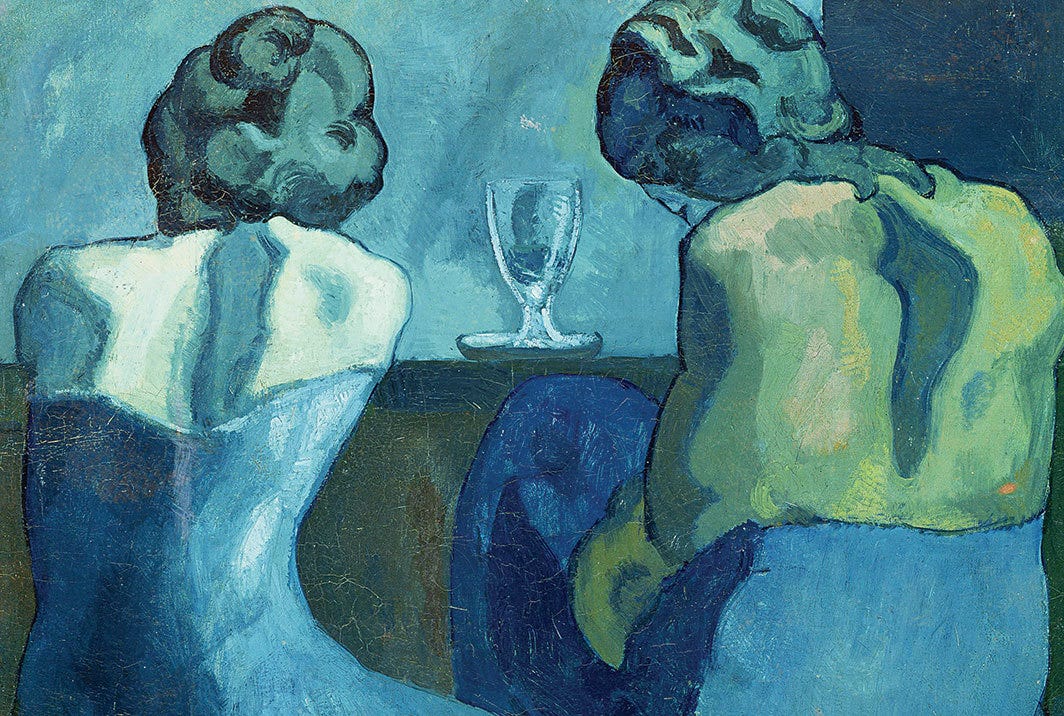Blue
London is grey even when it should be Blue. It is Saturday, after lunch. The sun hovers, full up. 32 degrees today, the hottest of summer, nearing the middle of September. The houses, their tarmacs, lamposts and driveway cars glitter in the heat. Everyone is outside, hardly dressed, numbing themselves with pimms. Sun drunk snooze, preparing for Sunday and then, Monday. The carpet-cladded floors hold heat, keeping houses warm. It’s English, no one thought of heatwaves in Victorian times.
You were in yellow. Yellow is made up of red and green pigments in equal parts, and green is made by mixing yellow and Blue. Apparently the colour Blue doesn’t so much exist in nature, only in the seas and skies or that’s why they think ancient Greeks didn’t name it first.
Blue is my favourite colour. When I joined primary school, they let us choose our sports house and I chose Blue. But after a fight with two older brothers and one older cousin, I was delegated yellow where I met you.
Yellow was first made in India where cows would only eat a diet of mangoes to collect bright piss, to distil and dry into yellow pigments of bliss. Mangoes are my favourite fruit.
The Greeks did not name Blue first because it seems humans could not see it until modern times. The Egyptians found Blue whilst mining Afghanistan around 6000 years ago. They extracted Blue from the highly precious stone, lapis lazuli which made Blue an expensive and rare sight for a number of years.
When you look at old paintings, bright Blues and yellows come far and few unless you are Renaissance painter, Raphael, paid to adorn the Virgin Mary in her Blue cloak.
In 2006, Goldsmiths University figured maybe the Greeks didn't have Blue because they couldn’t see Blue just as maybe I couldn’t see you? They called on the Himba tribe in Namibia to test their theory; the Himba tribe did not have a word for you either. So they showed them screens with different dots of green and dots of you. People in the tribe couldn't see the dots that were Blue.
The Egyptians buried Cleopatra with Blue stones to warm her eyes.
Your eyes were Blue too but like the skies and ocean, not natively so. They were pale like they’d been washed too many times by the refracted light and impressions of red, yellow or green?
Blue amplified when you recalled a story about cycling by a double-decker bus. You said it made you feel like a whale next to ocean waves. If you didn’t embrace Blue, it would engulf you.
At low tides, Blue smells like a chemical called dictyopterenes, a sex pheromone produced by seaweed eggs to attract their sperm.
On nights I can’t sleep, I listen to relaxing sounds with titles like, ‘Ocean & Rain’.
I laid awake that night listening to Blue tapping against my window, wishing I’d look out to you throwing rocks, carrying a boombox. As Blue settled, the droplets tinkled like a soprano, leaving only a faint print of Blue’s hand where it pressed against the window. It looked like tears when I tilted to see a rimming shadow of black.
I briefly encountered black on the edges of your nailbed, in a conversation about Blue, you gave me a mission to pinch tobacco you promised to roll. I thought I smelt the pillowing softness hissing between our parted lips. Then you returned my cardigan and afraid it might fade, I sniffed till my head hurt so I could trap it behind a chronic migraine.
Migraines from when you and I ate M&M's till our tongues turned Blue in year 3 when you taught me how to say the word ‘fuck’ till I cried cold, and Blue smelt like menthol.
Menthol exhibits unique, multiple, and paradoxical sensory effects when applied externally to the skin or mucous membranes. Menthol application at low doses produces a cooling sensation, whereas, at higher doses, it evokes burning, irritation, and pain.
